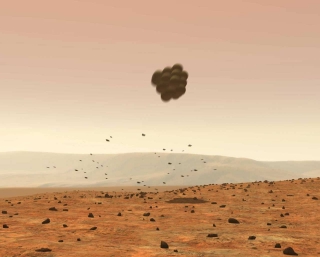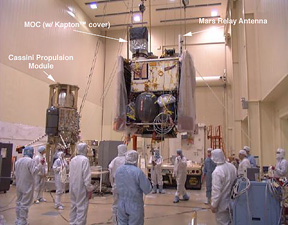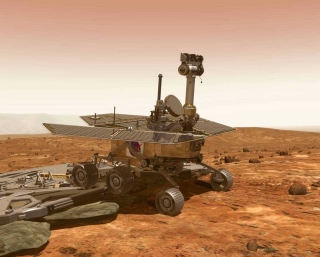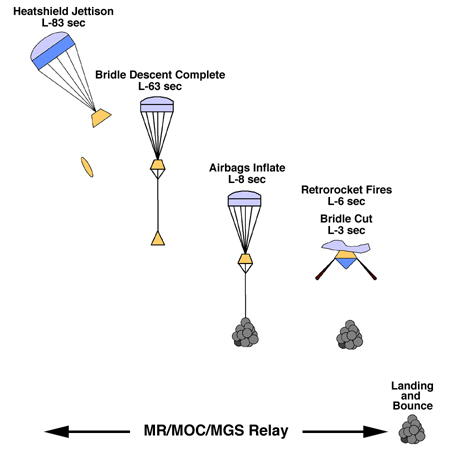 |
 |
 Entry, Descent, and Landing |
 Mars Global Surveyor in 1996--note Relay Antenna |
 Impact-to-Egress |
During January 2004, the MGS Mars Relay was used as the primary system to acquire Entry, Descent, and Landing (EDL) telemetry from both MER-A (Spirit) and MER-B (Opportunity). After landing, MGS was also used to return science data, along with its sister orbiter, Mars Odyssey.
Below are technical descriptions regarding how the MER data were relayed to Earth via the MGS MR and MOC.
MER EDL

The MR/MOC/MGS role in EDL began just under a minute and a half prior to landing, when the MER lander was about 6 km above the surface and falling at just over 70 m/sec. The parachute, recently deployed, slowed the descent from over 400 m/sec, and the heatshield has been jettisoned. As the lander descended the bridle below the parachute (which gaves room for the airbags to inflate and moves the lander away from the blast of the landing rockets), it listened for the MR tone coming from MGS. MGS at that point had risen above the horizon as seen from the MER several minutes earlier, already transmitting its tone and listening in return for UHF signals.
Simultaneous with transmitting its telemtry, the lander continued through its sequence, detecting the surface using radar when at an altitude of about 2.5 km, and acquiring descent images to determine the relative ground motion. At about 8 seconds from landing, the airbags were inflated. At L-6 seconds and an altitude of about 115 m, the retrorockets were fired, slowing the descent to near zero at an altitude of about 15 m, at which point the bridle was cut and the airbag-enshrouded MER dropped to the surface and rolled and bounced for as much as a minute (the parachute, bridle and retrorockets pop up and away with the release of the weight of the lander and fall to the ground several hundred meters away). The MR was receiving and storing data from the landers in the MOC memory throughout this period. MGS continued to listen for the signal from the lander for about 10 minutes after it touched down, as the orbiter moved away from the landing site.
The amount of data the MOC collected was dependent on the exact circumstances of the landing. For the several minutes prior to the receiving telemetry from the MER, the MR is continually checking for the MER signal and its own, internal health and welfare. The house-keeping telemetry, or HKTM, consists of 1320 bits of data appended to each 16 second collection cycle. Included in these bits are three doppler frequency measurements that can be used to determine the location of the lander. In the minutes leading up to the landing, the MOC recorded only about 30 Kbits of data. Since the basic unit of MOC memory is just under 2 Mbits in size, the HKTM constitutes a tiny fraction of the memory allocated to landing telemetry. Even when the MER began transmitting at 8 Kbps, the entire EDL sequence, lasting about 85 sec, only generated about 700 Kbits. The MER will continued to transmit data after it lands. When the MR received these data, then about 3 minutes after landing the first memory unit, or fragment, was filled and another fragment was used to collect more data. MOC automatically returned the MER data at the end the MGS overflight of the landing location, about 10 minutes after landing.
Internal MOC telemetry told how many fragments of memory were being used. When we saw that more than one fragment was used, we had direct confirmation that the landings were successful.
Once the data were returned to Earth, automatic software running at Malin Space Science Systems found the data on the JPL master data server, retrieved the data, processed them, and placed them back on another server at JPL where MER project engineers could access them. This occurred less than 15 minutes after landing.
The EDL data were not only sent directly to Earth, they were also being recorded on the MGS spacecraft. On the orbit after landing (about 1.5 hr later), the contents of the recorder were played back several additional times to insure these critical data were successfully received at the MER operations area.
After landing, the MER went through a long and complicated process of deflating the airbags, righting itself, opening the lander petals, and deploying various appendages such as the Pancam Mast Assembly (PMA) on which the Navigation and Panorama cameras and MiniTES thermal spectrometer are mounted. Since for both landers d all went well in this sequence of events, the MERs signalled their successful deployments when the Odyssey orbiter flew over each lander about two hours after landing. Following its initial, autonomous deployments, each MER was prepared for driving off the lander and conducting its science mission. Because many of these activities require "humans in the loop," they were spread out over several martian days (sols). MGS provided as many as four engineering relay sessions each day until each rover was safely off its lander.
During most of each rover's 90-sol mission, MGS will provided science data return support by relaying science data. The principal factor determining along which path data were returned from the MER is the length of time that elapses between when the data are acquired and when they show up at JPL, called the data latency. X-band direct to Earth transmissions take only seconds, data transmitted to Odyssey usually reside on that spacecraft for an hour or two, but owing to the way MGS records and plays back data, most MER data sent to MGS spent from 24 to 48 hours in the spacecraft recorder before being returned to Earth. Any data that were needed to make decisions for the next day's activities (termed critical data) had to come back via DTE or Odyssey. About 40-50 Mbits of non-critical data (for example, pictures taken as part of a large mosaic) could be relayed per pass to the MR/MOC/UHF at 128 Kbps. Unlike Odyssey, any bits sent to Earth via MGS take away bits that could be used by MOC to take pictures of other places on Mars. Thus, there was a science trade-off between MER and MOC data. Early in the mission, this trade favored MER, since often the rover team was seeing things for the first time. Later in the mission the usefulness of MGS becomes reduced because the MGS data rates decreased rapidly as the Earth/Mars distance increased, so that MER just could not get as many bits back to Earth through the MGS relay.